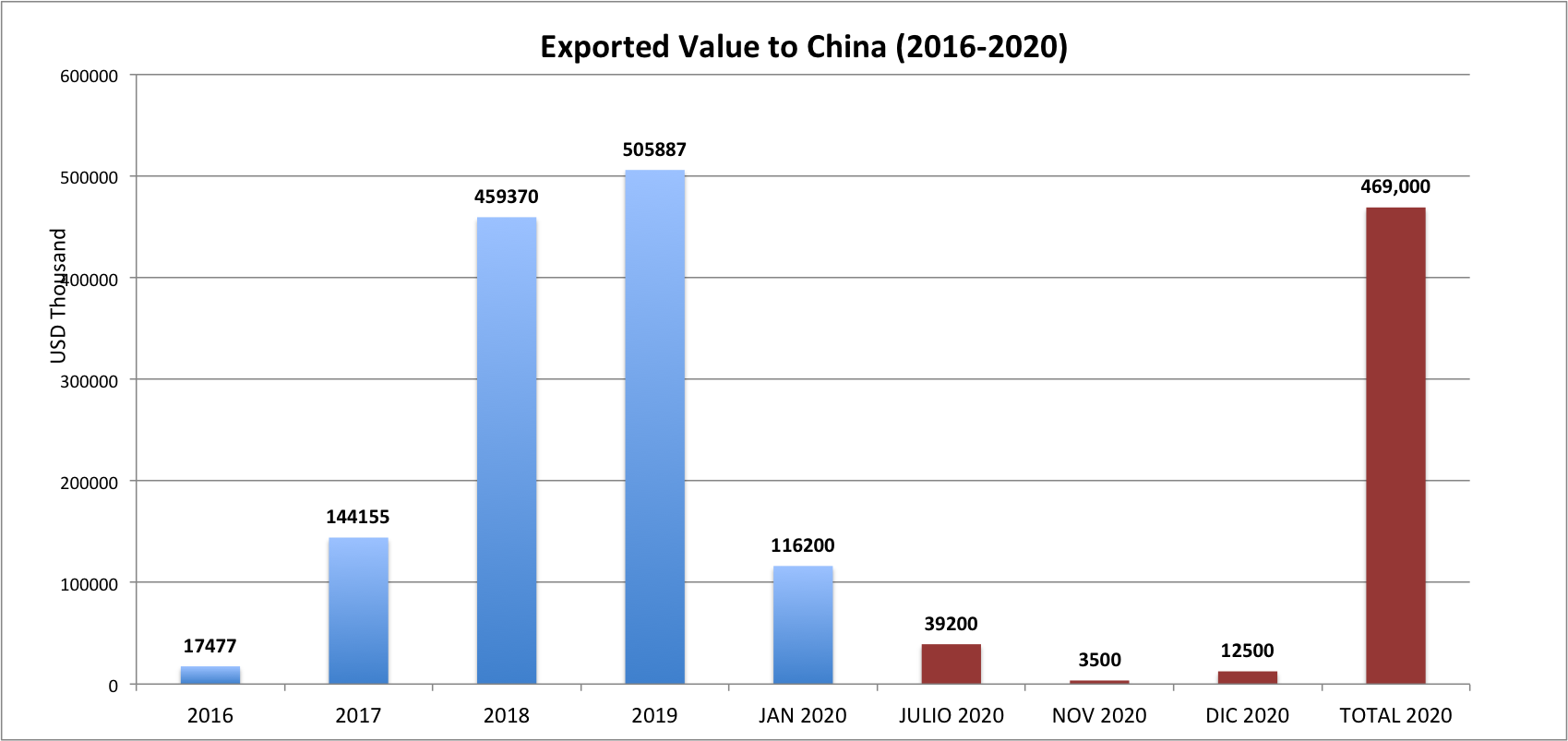Australian rock lobster in search of new markets
A Trade War Measure that Ends a Very Successful Relation
China officially banned the entry of lobsters from Australia on November 30th, 2020. This is particularly important for the Western and Southern Rock Lobster industry, which exports a total value of USD 527 million in 2019 and Mainland China represents an impressive 94% of its total exports value.
In 2019, China was the destination for USD 495 million of Australia’s rock lobster exports, accounting for the largest trade flow for this product and making it an essential market for the industry, which is centred in Western Australia and South Australia.
According to an estimation of the Fisheries Research and Development Corporation in Australia, the export value to China for rock lobster in 2020 was around USD 469 million, a number that would have been bigger than the previous year if exports have not collapsed in November and December due to the ban.
 Source: FRDC,Tridge
Source: FRDC,Tridge
The Seafood Trade Advisory Group reported at the beginning of November 2020, that even though the measures were not implemented back then, there was a continued risk of extreme delays while clearing customs in China as new processes were being implemented. To mitigate this risk a decision was made by the majority of new exporters to stop sending shipments to China until more is known about the new process.
Exports of lobster to China have been cleared in the domestic market causing historical low price
Australian fisheries had to instantly find a plan to allocate it’s yearly supply and seek for new markets. For this, they first thought locally and made some agreements with the major supermarkets to distribute Rock Lobster at discounted prices for the festive Christmas and New Years seasons.
As a result, the price of live lobsters in Australia has dropped as low as US$30 per kilogram, compared with $100 before. To the point where prices have dropped by 50% or more, rock lobster in Australia has now reached an historical minimum price of its 5-year average price.
Major suppliers and co-operatives from Western Australia have signed a contract with supermarket giants to clear shellfish on retail shelves across Australia at the relative bargain price of AUD $20 (or USD $15) each.

Exports redirection into new and different markets
As rock lobster has been disappearing from China’s food markets, even though the country has been trying to make up for the loss by increasing imports from the U.S., South Africa and other countries, the Australian rock lobster is determined to reinvent its commercialization into different markets.
According to Jose Salman, Tridge’s Engagement Manager in Australia,¨suppliers have been struggling to find a market as attractive as Mainland China, where they do value this luxury kind of lobster. Taiwan and Hong Kong have been the only markets where interest has been noted and there has been a slight increase in exports these last months, in order to try to compensate for the loss¨.
Exporters have seen themselves forced to make the price more competitive with the intention to open new market routes. After the Mainland China banned, the main lobster exporters are now opening routes outside Mainland but within the same country, as there now biggest export markets are Hong Kong and Taiwan.
Hong Kong
Hong Kong is the second largest importer of rock lobster in the world. In 2019, a value of USD 26.6 million was imported into the Hong Kong market. Australia however, is the biggest supplier for rock lobster in Hong Kong, representing 26% of the imports with a value of USD 6.9 million per year.
The rest of the import share belongs to the U.S. with 24.7% of the share, Mexico with 15.4% and South Africa with 7.2%, all of them also small suppliers of Mainland China.
Taiwan
Taiwan is reported to have one of the biggest increases of rock lobster in the world in recent years. They went from importing USD 7 million in 2012 to USD 13.8 million in 2019, having Indonesia as its main supplier with a USD 9.2 million value, accounting for 70% of the Taiwanese market share.
Australia in this case just has 4.3% of the share behind other suppliers such as; South Africa (6.9%), Portugal (5.2%) and the U.S. (4.8%).
Sources:
- Australian fisheries and aquaculture outlook 2020
- Reuters, ¨Australian lobster halted by Chinese customs checks, fuels trade dispute concerns¨
- The Sydney Morning Herald, ¨Australian lobster exports feared latest victim of China tensions¨
- Fisheries Research and Development Corporation
- Food Processing, ¨Chinese Ban Slashes Australian Lobster Prices¨
- The Wall Street Journal, ¨Australia Is Awash in Lobster¨


